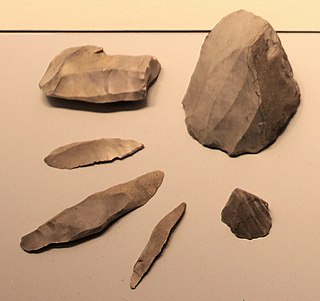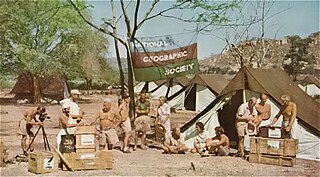Related Research Articles

A microlith is a small stone tool usually made of flint or chert and typically a centimetre or so in length and half a centimetre wide. They were made by humans from around 35,000 to 3,000 years ago, across Europe, Africa, Asia and Australia. The microliths were used in spear points and arrowheads.
Australian archaeology is a large sub-field in the discipline of archaeology. Archaeology in Australia takes four main forms: Aboriginal archaeology, historical archaeology, maritime archaeology and the archaeology of the contemporary past. Bridging these sub-disciplines is the important concept of cultural heritage management, which encompasses Aboriginal and Torres Strait Islander sites, historical sites, and maritime sites.

Australian Aboriginal artefacts include a variety of cultural artefacts used by Aboriginal Australians. Most Aboriginal artefacts were multi-purpose and could be used for a variety of different occupations. Spears, clubs, boomerangs and shields were used generally as weapons for hunting and in warfare. Watercraft technology artefacts in the form of dugout and bark canoes were used for transport and for fishing. Stone artefacts include cutting tools and grinding stones to hunt and make food. Coolamons and carriers such as dillybags, allowed Aboriginal peoples to carry water, food and cradle babies. Message sticks were used for communication, and ornamental artefacts for decorative and ceremonial purposes. Aboriginal children’s toys were used to both entertain and educate.

The Dharug language, also spelt Darug, Dharuk, and other variants, and also known as the Sydney language, Gadigal language, is an Australian Aboriginal language of the Yuin–Kuric group that was traditionally spoken in the region of Sydney, New South Wales, until it became extinct due to effects of colonisation. It is the traditional language of the Dharug people. The Dharug population has greatly diminished since the onset of colonisation. Eora language has sometimes been used to distinguish a coastal dialect from hinterland dialects, but there is no evidence that Aboriginal peoples ever used this term, which simply means "people". Some effort has been put into reviving a reconstructed form of the language.

Roger Llewellyn Dunmore Cribb was an Australian archaeologist and anthropologist who specialised in documenting and modelling spatial patterns and social organisation of nomadic peoples. He is noted for conducting early fieldwork amongst the nomadic pastoralists of Anatolia, Turkey; writing a book on the archaeology of these nomads; pioneering Australian archaeology and anthropologies' use of geographical information systems, plus genealogical software; and conducting later fieldwork documenting the cultural landscapes of the Aboriginal peoples of Cape York Peninsula.
Peter Dixon Hiscock is an Australian archaeologist. Born in Melbourne, he obtained a PhD from the University of Queensland. Between 2013 and 2021, he was the inaugural Tom Austen Brown Professor of Australian Archaeology at the University of Sydney, having previously held a position in the School of Archaeology and Anthropology at the Australian National University.
Narrabeen Man is the name given to a 4,000-year-old skeleton of a tall Aboriginal Australian man found in Narrabeen, a suburb of the Northern Beaches region of Sydney, in January 2005.

Catherine Helen Berndt, néeWebb was a New Zealand-born Australian anthropologist known for her research in Australia and Papua New Guinea conducted jointly with her husband, Ronald Berndt.
Derek John Mulvaney, known as John Mulvaney and D. J. Mulvaney, was an Australian archaeologist. He was the first qualified archaeologist to focus his work on Australia.
David Frankel is Emeritus Professor in Archaeology, Faculty of Humanities and Social Sciences, Department of Archaeology and History at La Trobe University.
Harry Lourandos is an Australian archaeologist, adjunct professor in the Department of Anthropology, Archaeology and Sociology, School of Arts and Social Sciences at James Cook University, Cairns. He is a leading proponent of the theory that a period of hunter-gatherer intensification occurred between 3000 and 1000 BCE.

The University of Queensland Anthropology Museum is located in Brisbane, Australia. It houses the largest university collection of ethnographic material culture in Australia.
Clifton Cappie Towle (1888–1946), founding member of The Anthropological Society of New South Wales in 1928 with William Walford Thorpe. Clifton Towle was born in Penrith, New South Wales, Australia on 15 Mar 1891 to Charles Towle and Laura A Gow. He obtained a Bachelor of Arts degree at University of Sydney in 1919 but spent much of his working life with the New South Wales Government Railways and followed his interest in anthropology as a very active amateur, gaining knowledge from his own private reading and field observations, and donated many wood and stone Aboriginal artefacts and photographs to Hornshaw’s collection. He travelled to south western Queensland and western New South Wales on these field trips. His personal collection of Aboriginal artefacts was donated to the Australian Museum on his death in 1946.

Frederick David McCarthy was an Australian anthropologist and archaeologist. He worked at the Australian Museum in Sydney and was Foundation Principal of the Australian Institute of Aboriginal Studies, with interests covering Australian archaeology, museology and Aboriginal rock art.
Sandra Bowdler is an Australian archaeologist, emeritus professor of archaeology and former head of the Archaeology Department at the University of Western Australia.
Isabel McBryde AO is an Australian archaeologist and emeritus professor at the Australian National University (ANU) and School Fellow, in the School of Social Sciences, Faculty of Arts. McBryde is credited with training "at least three generations of Australian archaeologists" and is affectionately referred to as the "Mother of Australian Archaeology". McBryde had a "holistic" approach to studying the archaeology of Aboriginal Australia, which has been carried on by many of her students. McBryde has also made considerable contributions to the preservation and protection of Australian cultural heritage, particularly Aboriginal cultural heritage.
Betty Francis Meehan is an Australian archaeologist and anthropologist who has worked extensively with Aboriginal people in Arnhem Land, Northern Territory.
Dr Josephine McDonald is an Australian archaeologist and Director of the Centre for Rock Art Research + Management at the University of Western Australia. McDonald is primarily known for her influence in the field of rock art research and her collaborative research with Australian Aboriginal communities.
Caroline Bird is an Australian archaeologist and educator. She specialises in women's studies, cultural heritage, and indigenous studies in the archaeological context, specifically early Australian archaeology. Bird's other focuses include lithic technology and art.
Lynley A. Wallis is an Australian archaeologist and Associate Professor at Griffith University. She is a specialist in palaeoenvironmental reconstruction through the analysis of phytoliths.
References
- 1 2 Specht, Jim; Torrence, Robin (2011). "Changing Perspectives in Australian Archaeology. Preface". Technical Reports of the Australian Museum, Online. 23: 1–2. doi: 10.3853/j.1835-4211.23.2011.1565 .
- ↑ Australian Museum Staff Profiles
- ↑ Australian Academy of the Humanities Honorary Fellows
- ↑ Attenbrow, Valerie (2010), Sydney's Aboriginal past : investigating the archaeological and historical records (2nd ed.), University of New South Wales Press, ISBN 978-1-74223-116-7
- ↑ "John Mulvaney Book Award". Australian Archaeological Association. Retrieved 9 January 2019.
- ↑ "Val Attenbrow | Australian Archaeological Association | AAA". australianarchaeologicalassociation.com.au. Retrieved 9 January 2019.
- ↑ "Fellows: Valerie Attenbrow". Australian Academy of the Humanities. Retrieved 28 October 2020.
- ↑ AustArchAssoc (13 December 2019). "#AAA42 Congratulations to the winner of the Rhys Jones Medal for Outstanding Contribution to Australian Archaeologypic.twitter.com/5lIHxhYqPH". @AustArchaeology. Retrieved 14 December 2019.